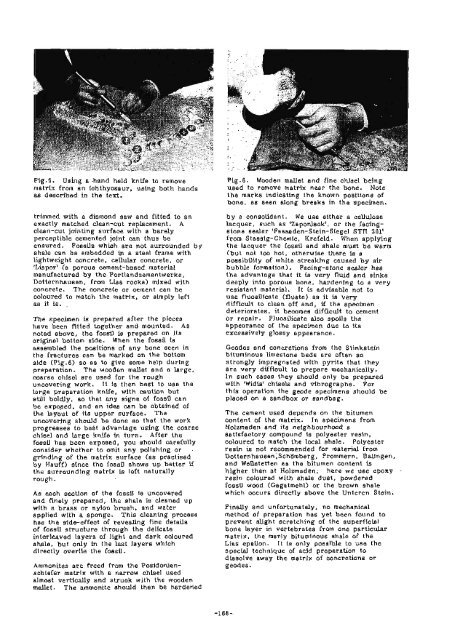Number 3 - Geological Curators Group
Number 3 - Geological Curators Group
Number 3 - Geological Curators Group
You also want an ePaper? Increase the reach of your titles
YUMPU automatically turns print PDFs into web optimized ePapers that Google loves.
Fig.5. Using a .hand held knife to removematrix from an ichthyosaur, using both handsas described in the text.trimmed with a diamond saw and fitted to anexactly matched clean-cut replacement. Aclean-cut jointing surface with a barelyperceptible cemented joint can thus heensured. Fossils which are not surrounded byshale can be emhedded in a steel frame withlightweight concrete, cellular concrete, or'Liapor' (a porous cement-hased materialmanufactured bv the Portlandzementwerke.Dotternhausen, "from Lias rocks) mixed withconcrete. The concrete or cement can becoloured to match the matrix, or simply leftas it is. ,The specimen is prepared after the pieceshave been fitted together and mounted. Asnoted above, the fossil is prepared on itsoriginal bottom side. When the fossil isassembled the positions of any hone seen inthe fractures can be marked on the bottomside (Fig.6) so as to give some help duringpreparation. The wooden mallet and a large,coarse chisel are used for the roughuncovering work. It is then hest to use thelarge preparation knife, with caution hutstill boldly, so that any signs of fossil canbe expo~ed, and an idea can be obtained ofthe layout of its upper surface. Theuncovering should be done so that the workprogresses to best advantage using the coarsechisel and large knife in turn. After thefossil has been exposed, you should carefullyconsider whether to omit any polishing orgrinding of the matrix surface (as practisedby Hauff) since the fossil shows up better ifthe surrounding matrix is left naturallyrough.As each section of the fossil is uncoveredand finely prepared, the shale is cleaned upwith a brass or nylon brush, and waterapplied with a sponge. This cleaning processhas the side-effect of revealing fine detailsof fossil structure through the delicateinterleaved layers of light and dark colouredshale, but only in the last layers whichdirectly overlie the fossil.Ammonites are freed from the Posidonienschiefermatrix with a narrow chisel usedalmost vertically and struck with the woodenmallet. The ammonite should then be hardenedFig.6. Wooden mallet and fine chisel beingused to remove matrix near the hone. Notethe marks indicating the known positions ofbone, as seen along breaks in the specimen.by a consolidant. We use either a celluloselacquer, such as 'Zaponlack', or the facingstonesealer 'Fassaden-Stein-Siege1 STH 201'from Stassig-Chemie, Krefeld. When applyingthe lacquer the fossil and shale must be warm(but not too hot, otherwise there is apossibility of white streaking caused by airbubble formation). Facing-stone sealer hasthe advantage that it is very fluid and sinksdeeply into porous bone, hardening to a veryresistant material. It is advisable not touse fluosilicate (fluate) as it is verydifficult to clean off and, if the specimendeteriorates, it becomes difficult to cementor repair. Fluosilicate also spoils theappearance of the specimen due to itsexcessively glossy appearance.Geodes and concretions from the Stinksteinbituminous limestone beds are often sostrongly impregnated with pyrite that theyare very difficult to prepare mechanically.In such cases they should only be preparedwith 'Widia' chisels and vibrographs. Forthis operation the geode specimens should beplaced on a sandbox or sandbag.The cement used depends on thebitumencontent of the matrix. In specimens fromHolzmaden and its neighhourhood asatisfactory compounduis polyester resin,coloured to match the local shale. Polyesterresin is not recommended for material fromDotternhausen;SchBmberg, Frommern, Balingen,and Weilstetten as the bitumen content ishigher than at Holzmaden; here we use epoxyresin coloured with shale dust, powderedfossil wood (Gagatmehl) or the brown shalewhich occurs directly above the Unteren Stein.Finally and unfortunately, no mechanicalmethod of preparation has vet been found toprevent slight scratching of the superficialbone layer in vertebrates from one particularmatrix, the marly bituminous shale of theLias epsilon. It is only possible to use thespecial technique of acid preparation todissolve away the matrix of concretions orgeodes.
















